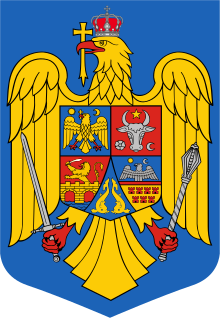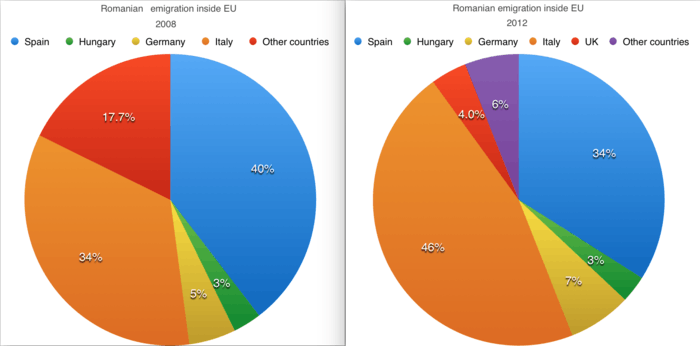Romanian diaspora
The Romanian diaspora is the ethnically Romanian population outside Romania and Moldova. The concept does not usually include the ethnic Romanians who live as natives in nearby states, chiefly those Romanians who live in Ukraine and Serbia. Therefore, the number of all Romanians abroad is estimated at about 4–12 million people, depending on one's definition of the term "Romanian" as well as the inclusion/exclusion of ethnic Romanians living in nearby countries where they are indigenous. The definition of "who is a Romanian?" may range from rigorous conservative estimates based on self-identification and official statistics to estimates that include people of Romanian ancestry born in their respective countries as well as people born to ethnic-minorities from Romania.
| Part of a series of articles on |
| Romanians |
|---|
 |
|
Native communities |

In 2006, the Romanian diaspora was estimated at about 8 million people by the president of Romania, Traian Băsescu, most of them living in the former USSR, Western Europe (esp. Italy, Spain, Germany, United Kingdom, and France), North America, South America, and Australia.[1] It is unclear if Băsescu included the indigenous Romanians living in the immediate surroundings of the Romanian state such as those in Moldova, Ukraine, or Serbia.
In December 2013, Cristian David, the government minister for the Department of Romanians Everywhere, declared that a new reality illustrates that between 6–8 million Romanians live outside Romania's borders. This includes 2–3 million indigenous Romanians living in neighbouring states such as Ukraine, Hungary, Serbia, Bulgaria, the Balkans and especially the Republic of Moldova. The number also includes circa 2.7–3.5 million Romanians in Western Europe.[2]
The Romanian diaspora has emerged as a powerful political force in elections since 2009.[3][4] For the 2014 presidential election, voting in the diaspora was poorly organized and resulted in protests in several major European cities. The diaspora vote played a key role in the final result.[4]
Below is a list of self-declared ethnic Romanians in the countries where they live, excluding those who live in Romania and Moldova but including those who live in Ukraine (including Chernivtsi Oblast), Serbia (including Vlachs), Hungary, and Bulgaria.
The numbers are based on official statistical data in the respective states where such Romanians reside or – wherever such data is unavailable – based on official estimates made by the Romanian department for Romanians abroad (figures for Spain, Italy, Germany, the United Kingdom, France, Sweden, Portugal, and Turkey are for Romanian citizens, and may include individuals of any ethnicity).
Ethnic Romanians are primarily present in Europe and North America. However, there are ethnic Romanians in Turkey, both in the Asian and European parts of the country, descendants of Wallachian settlers invited by the Ottoman Empire from the early fourteenth to the late nineteenth centuries. There are about 2,000 Romanian immigrants in Japan since the late twentieth century.[5]
Distribution by country

| Country | Year | Population | Origin, notes |
|---|---|---|---|
| 2020 | 1,207,919[6] | Immigrants (additional 128,979 Moldovans) | |
| 2018 | 965,000[7] | Immigrants (additional 14,815 Moldovans)[8] (the overall number of people with Romanian ancestry in Germany includes many Romanian-Germans as well) | |
| 2020 | 593,532 / 671,985 (2020)[lower-alpha 1] | Immigrants (additional 17,868 Moldovans) | |
| 2015 | 468,994[12] (ancestry)
165,199 (born in Romania) |
Immigrants | |
| 2019 | 450,000[13] | Immigrants (additional 18,000 Moldovans) | |
| 2016 | 238,050[14] | Immigrants (additional 14,915 Moldovans) | |
| 2014 | 205,600[15] | Immigrants (includes many Romanian Jews) | |
| 200,000[16] | Immigrants | ||
| 2001 | 150,989[17] | Indigenous to Zakarpattia Oblast, Odessa Oblast and Chernivtsi Oblast (additional 258,619 Moldovans) | |
| 2020 | 123,461[18] | Immigrants, of whom 36,000 live in Vienna[19] | |
| 2016 | 118,400[20] | Immigrants | |
| 2019 | 96,034[21] | Immigrants | |
| 2011 | 46,523[22] | Immigrants (additional 10,391 Moldovans). There are also 209,000 Aromanian[23] and 3,000 Megleno-Romanian[24] speaking people in Greece; however, they are not considered an ethnic but a linguistic/cultural minority. | |
| 2019 | 34,185[25] | Immigrants (additional 986 Moldovans) | |
| 2019 | 32,294[26] | Immigrants (additional 938 Moldovans) | |
| 2018 | 30,504[27] | Immigrants (additional 8,460 Moldovans) | |
| 2011 | 30,924[28] | Indigenous to Eastern Hungary; Immigrants | |
| 2011 | 29,332[29] | Indigenous to Vojvodina and the Timok Valley (additional 35,330 Vlachs and 243 Cincars) | |
| 2016 | 29,186[30] | Immigrants | |
| 2017 | 24,422[31] | Immigrants (additional 686 Moldovans) | |
| 2011 | 24,376[32] | Immigrants | |
| 2015 | 21,593[33] | Immigrants | |
| 2011 | 20,998[34] | Immigrants | |
| 2019 | 18,625[35] | Immigrants | |
| 2018 | 14,684[36] | Immigrants (additionally 5,811 Moldovans) | |
| 2009 | 14,666[37] | Displaced and deported during World War II (including Moldovans) | |
| 14,000[38] | Immigrants | ||
| 10,000[39] | Immigrants | ||
| 10,000 | Immigrants | ||
| 2017 | 8,474[40] | Immigrants | |
| 6,444[41] | Immigrants | ||
| 2019 | 5,209[42] | Immigrants | |
| 4,000[41] | Immigrants | ||
| 2010 | 3,201[43] | Immigrants/Displaced during World War II (additional 586,122 Moldovans) | |
| 3,100 | Immigrants | ||
| 3,000 | Immigrants | ||
| 2,000[41] | Immigrants | ||
| 2013 | 1,742[44] | Immigrants | |
| 1,320[41] | Immigrants | ||
| 1,000[41] | Immigrants | ||
| 1,000[41] | Immigrants | ||
| 2011 | 891[45] | Indigenous to Vidin Province and parts of Northern Bulgaria (additional 3,684 Vlachs) | |
| 850[41] | Immigrants | ||
| 696[41] | Immigrants | ||
| 634[41] | Immigrants | ||
| 600[41] | Immigrants | ||
| 485 | Immigrants | ||
| 420[41] | Immigrants | ||
| 400[41] | Immigrants | ||
| 400[41] | Immigrants | ||
| 398[41] | Immigrants | ||
| 382[41] | Immigrants | ||
| 350[41] | Immigrants | ||
| 2018 | 283[46] | Immigrants | |
| 250[41] | Immigrants | ||
| 200[41] | Immigrants | ||
| 174[41] | Immigrants | ||
| 155[41] | Immigrants | ||
| 106[41] | Immigrants | ||
| 100[41] | Immigrants | ||
| 100[41] | Immigrants (additional 9,900 Aromanians[47] and 2,100 Megleno-Romanians)[48] | ||
| 100[41] | Immigrants | ||
| 2011 | 77[49] | Immigrants | |
| 75[41] | Immigrants | ||
| 2011 | 63[50] | Immigrants (additional 1,919 Moldovans) | |
| 30[41] | Immigrants | ||
| 15[41] | Immigrants | ||
| There live up to 300,000 Aromanians, but Albanian authorities do not recognize them as Romanian minority.[51] | |||
| Total | 5,019,503 | The estimate is the sum of the countrywide estimates listed. To this are added 1,618,650 people belonging to ethnic groups Romanian authorities claim to be part of the Romanian population (e.g., Moldovans, Aromanians, Megleno-Romanians). The total estimate is roughly 6.6 million. |
Notes
References
- Preşedintele României
- 6-8 Million Romanians Live outside Romania's Borders
- "REZULTATE ALEGERI 2014 [Results of 2014 election]". Retrieved 21 November 2014.
- "Romania election surprise as Klaus Iohannis wins presidency". Retrieved 21 November 2014.
- Departamentul Românilor de Pretutindeni Archived 2012-08-05 at Archive.today
- "Resident foreigners on 1st January - Citizenship". I.Stat.
- "Bevölkerung in Privathaushalten nach Migrationshintergrund im weiteren Sinn nach ausgewählten Herkunftsländern". Statistisches Bundesamt.
- "Anzahl der Ausländer in Deutschland nach Herkunftsland in den Jahren 2014 und 2015". Statista (in German).
- https://epa.com.es/padron/rumanos-en-espana/
- "Población (españoles/extranjeros) por País de Nacimiento, sexo y año". Instituto Nacional de Estadística. 2018. Retrieved 26 January 2019.
- "Población extranjera por Nacionalidad, comunidades, Sexo y Año". Instituto Nacional de Estadística. 2018. Retrieved 26 January 2019.
- "People Reporting Ancestry". American FactFinder. United States Census Bureau. Archived from the original on 14 February 2020. Retrieved 4 April 2017.
- "Population of the UK by country of birth and nationality". Office for National Statistics.
- "2016 Census Profile: Ethnic Origin Population (data tables)". Statistics Canada. Retrieved 24 November 2019.
- "Jews, by country of origin and age". CBS, Statistical Abstract of Israel 2014.
- Gabriel Bejan, Petre Bădică (16 February 2008). "200.000 de români trăiesc "visul brazilian"". România liberă (in Romanian).
- "National composition of population". All-Ukrainian population census 2001. State Statistics Committee of Ukraine.
- "Anzahl der Ausländer in Österreich nach den zehn wichtigsten Staatsangehörigkeiten am 1. Januar 2020". Statista (in German).
- "Menschen in Wien" (PDF). Statistiches Jahrbuch der stadt Wien - 2017 (in German).
- "Étrangers – Immigrés : pays de naissance et nationalités détaillés". Institut national de la statistique et des études économiques.
- "Foreign population of Belgium in 2019, by origin".
- "2011 Population and Housing Census". Hellenic Statistical Authority. Piraeus. 12 September 2014. Archived from the original on 23 January 2017. Retrieved 4 April 2017.
- "Aromanian in Greece". Joshua Project.
- "Meglenite, Vlasi in Greece". Joshua Project.
- "Bevolking; generatie, geslacht, leeftijd en herkomstgroepering, 1 januari". Centraal Bureau voor de Statistiek (in Dutch).
- "Befolkning efter födelseland, ålder, kön och år". Statistics Sweden (in Swedish).
- "População estrangeira residente em território nacional - 2014" (PDF). Serviço de Estrangeiros e Fronteiras (in Portuguese). June 2012.
- "3. Országos adatok" (PDF). 2011. évi népszámlálás (in Hungarian). Budapest: Központi Statisztikai Hivatal. 2013. ISBN 978-963-235-417-0.
- Становништво према националној припадности. РЗС (in Serbian). Archived from the original on 14 January 2015.
- Census 2016 Summary Results - Part 1 (PDF). Central Statistics Office. 2017. p. 52. ISBN 978-1-4064-2761-5.
- "Folketal 1. januar efter køn, alder og fødeland". Danmarks Statistik (in Danish).
- "Preliminary Results of the Census of Population, 2011". Statistical Service of the Republic of Cyprus. 29 December 2011.
- "Permanent and non permanent resident population by canton, sex, citizenship, country of birth and age, 2014-2015". Federal Statistical Office.
- The People of Australia (PDF). Department of Immigration and Border Protection. Australian Government. 2014. ISBN 978-1-920996-23-9. Archived from the original (PDF) on 17 April 2017. Retrieved 4 April 2017.
- "Immigrants and Norwegian-born to immigrant parents, 1 January 2016". Statistics Norway.
- Madalin Danciu (31 December 2018). "Foreigners in the Czechia by citizenship". CZSO.
- "Socio-economic development of the Republic of Kazakhstan". stat.gov.kz.
- Ana Ilie (20 July 2015). "Pentru ce facem moschee la București: În căutarea românilor ortodocși din Turcia". Ziare.com (in Romanian).
- V. C. (11 March 2011). "Câți români sunt în Japonia? Invazia dansatoarelor românce". HotNews.ro (in Romanian).
- Andrei Luca Popescu (21 December 2015). "HARTA românilor plecați în străinătate. Topul țărilor UE în care românii reprezintă cea mai mare comunitate". Gândul (in Romanian).
- Anca Melinte (25 September 2015). "Câți români au părăsit România pentru a trăi în străinătate". Viața liberă (in Romanian).
- "Population by nationalities in detail 2011 - 2019". Statistiques // Luxembourg.
- Том 1. Численность и размещение населения. ВПН-2010 (in Russian).
- Cristina Șomănescu (30 November 2013). "Câți români muncesc în străinătate și unde sunt cei mai mulți". Economica.net (in Romanian).
- "Население по етническа група и майчин език". National Statistical Institute (in Bulgarian). Archived from the original on 19 December 2015. Retrieved 4 April 2017.
- "Aromanian in Macedonia". Joshua Project.
- "Meglenite, Vlasi in Macedonia". Joshua Project.
- "Comunitatea românească din Lituania și Letonia". Romanian Embassy in Lithuania (in Romanian).
- "TSG11-04. Latvijas pastāvīgie iedzīvotāji pēc dzimšanas valsts, dzimuma un pa vecuma grupām 2011.gada 1.martā". Centrālās statistikas pārvaldes datubāzes (in Lithuanian). Archived from the original on 3 September 2017. Retrieved 4 April 2017.
- "Dan Stoenescu a mers de Crăciun la românii/aromânii din Albania. 300.000 de români pe care Albania nu-i recunoaște ca minoritate românească și nu le dă drepturi! Ce a cerut România?". Romanian Global News (in Romanian). 28 December 2015. Archived from the original on 4 April 2017. Retrieved 4 April 2017.
External links
| Wikimedia Commons has media related to Romanian diaspora. |
